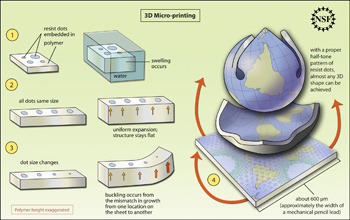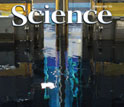News Release 12-045
Researchers 'Print' Polymers That Bend Into 3-D Shapes
Technique could be used to direct growth of blood vessels or tissues in the laboratory

Researchers can control the shape of a polymer system with a technique akin to half-tone printing.
March 8, 2012
This material is available primarily for archival purposes. Telephone numbers or other contact information may be out of date; please see current contact information at media contacts.
Christian Santangelo, Ryan Hayward and colleagues at the University of Massachusetts Amherst recently employed photographic techniques and polymer science to develop a new technique for printing two-dimensional sheets of polymers that can fold into three-dimensional shapes when water is added. The technique may lead to wide ranging practical applications from medicine to robotics
The journal Science publishes the research in its March 9 issue.
Researchers used a photomask and ultraviolet (UV) light to "print" a pattern onto a sheet of polymers, a technique called photolithography. In the absence of UV exposure, the polymer will swell and expand uniformly when exposed to water, however when polymer molecules within the sheet were exposed to UV light they became crosslinked--more rigidly linked together at a number of points--which prevented them from expanding when water was added. Patterning the amount of crosslinking across an entire sheet allowed researchers to control how much each area swelled. A second exposure to a carefully selected pattern of UV light allowed them to create specific 3-D shapes.
The work, supported by National Science Foundation (NSF) Faculty Early Career Development and Materials Research Science and Engineering Centers awards, is a collaborative effort between polymer engineering and physics, with both theoretical and experimental aspects.
"This paper reports an interesting fusion of experimental technique and theory to develop an innovative method for making self-actuating materials that will assume a desired three-dimensional shape," said Daryl Hess, a program director in the division of materials research at NSF.
For more information on this discovery, read the news release from the University of Massachusetts Amherst.
-NSF-
-
The researchers' work is described in the March 9, 2012 issue of the journal Science.
Credit and Larger Version
Media Contacts
Lisa Van Pay, NSF, (703) 292-8796, email: lvanpay@nsf.gov
Janet Lathrop, University of Massachusetts Amherst, (413) 545-0444, email: jlathrop@admin.umass.edu
Program Contacts
Daryl W. Hess, NSF, (703) 292-4942, email: dhess@nsf.gov
Principal Investigators
Christian Santangelo, University of Massachusetts Amherst, (413) 545-2099, email: csantang@physics.umass.edu
The U.S. National Science Foundation propels the nation forward by advancing fundamental research in all fields of science and engineering. NSF supports research and people by providing facilities, instruments and funding to support their ingenuity and sustain the U.S. as a global leader in research and innovation. With a fiscal year 2023 budget of $9.5 billion, NSF funds reach all 50 states through grants to nearly 2,000 colleges, universities and institutions. Each year, NSF receives more than 40,000 competitive proposals and makes about 11,000 new awards. Those awards include support for cooperative research with industry, Arctic and Antarctic research and operations, and U.S. participation in international scientific efforts.
Connect with us online
NSF website: nsf.gov
NSF News: nsf.gov/news
For News Media: nsf.gov/news/newsroom
Statistics: nsf.gov/statistics/
Awards database: nsf.gov/awardsearch/
Follow us on social
Twitter: twitter.com/NSF
Facebook: facebook.com/US.NSF
Instagram: instagram.com/nsfgov

